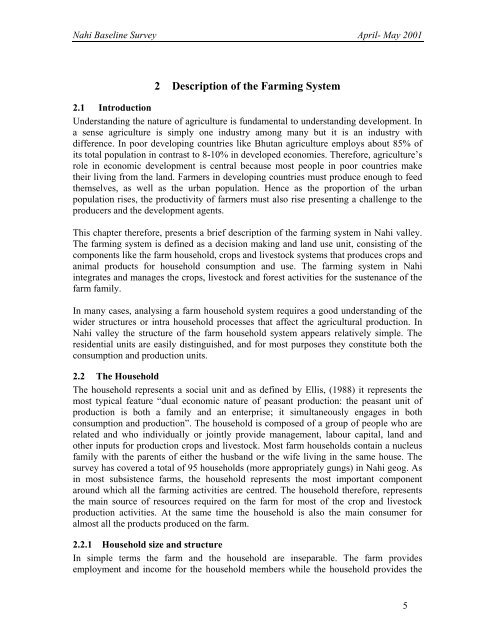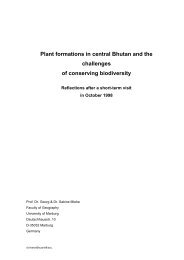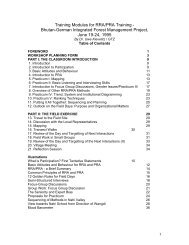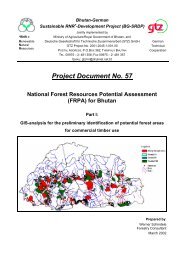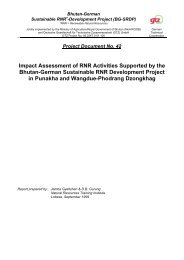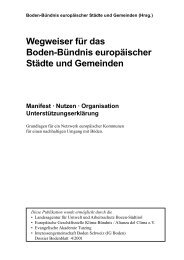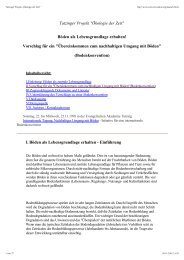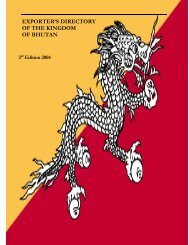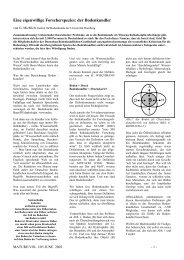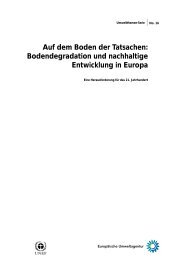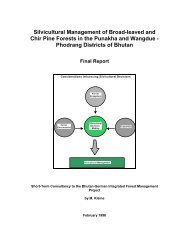GTZ Project Document No. 51 Report on Nahi Baseline Survey
GTZ Project Document No. 51 Report on Nahi Baseline Survey
GTZ Project Document No. 51 Report on Nahi Baseline Survey
You also want an ePaper? Increase the reach of your titles
YUMPU automatically turns print PDFs into web optimized ePapers that Google loves.
<strong>Nahi</strong> <strong>Baseline</strong> <strong>Survey</strong> April- May 20012 Descripti<strong>on</strong> of the Farming System2.1 Introducti<strong>on</strong>Understanding the nature of agriculture is fundamental to understanding development. Ina sense agriculture is simply <strong>on</strong>e industry am<strong>on</strong>g many but it is an industry withdifference. In poor developing countries like Bhutan agriculture employs about 85% ofits total populati<strong>on</strong> in c<strong>on</strong>trast to 8-10% in developed ec<strong>on</strong>omies. Therefore, agriculture’srole in ec<strong>on</strong>omic development is central because most people in poor countries maketheir living from the land. Farmers in developing countries must produce enough to feedthemselves, as well as the urban populati<strong>on</strong>. Hence as the proporti<strong>on</strong> of the urbanpopulati<strong>on</strong> rises, the productivity of farmers must also rise presenting a challenge to theproducers and the development agents.This chapter therefore, presents a brief descripti<strong>on</strong> of the farming system in <strong>Nahi</strong> valley.The farming system is defined as a decisi<strong>on</strong> making and land use unit, c<strong>on</strong>sisting of thecomp<strong>on</strong>ents like the farm household, crops and livestock systems that produces crops andanimal products for household c<strong>on</strong>sumpti<strong>on</strong> and use. The farming system in <strong>Nahi</strong>integrates and manages the crops, livestock and forest activities for the sustenance of thefarm family.In many cases, analysing a farm household system requires a good understanding of thewider structures or intra household processes that affect the agricultural producti<strong>on</strong>. In<strong>Nahi</strong> valley the structure of the farm household system appears relatively simple. Theresidential units are easily distinguished, and for most purposes they c<strong>on</strong>stitute both thec<strong>on</strong>sumpti<strong>on</strong> and producti<strong>on</strong> units.2.2 The HouseholdThe household represents a social unit and as defined by Ellis, (1988) it represents themost typical feature “dual ec<strong>on</strong>omic nature of peasant producti<strong>on</strong>: the peasant unit ofproducti<strong>on</strong> is both a family and an enterprise; it simultaneously engages in bothc<strong>on</strong>sumpti<strong>on</strong> and producti<strong>on</strong>”. The household is composed of a group of people who arerelated and who individually or jointly provide management, labour capital, land andother inputs for producti<strong>on</strong> crops and livestock. Most farm households c<strong>on</strong>tain a nucleusfamily with the parents of either the husband or the wife living in the same house. Thesurvey has covered a total of 95 households (more appropriately gungs) in <strong>Nahi</strong> geog. Asin most subsistence farms, the household represents the most important comp<strong>on</strong>entaround which all the farming activities are centred. The household therefore, representsthe main source of resources required <strong>on</strong> the farm for most of the crop and livestockproducti<strong>on</strong> activities. At the same time the household is also the main c<strong>on</strong>sumer foralmost all the products produced <strong>on</strong> the farm.2.2.1 Household size and structureIn simple terms the farm and the household are inseparable. The farm providesemployment and income for the household members while the household provides the5


